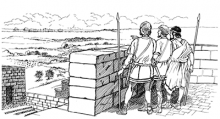
You are here
Episode 3: Stolen Love
Story summary
Teaching activities
- Starting points
- Follow-up
- Further activities
Episode 3 will be your third listening session, though you may have had more if you have broken down episodes into tracks, or if you have repeated episodes. Learners should now be in the habit of preparing the area in which you are going to listen. They should understand the conditions required to ensure a comfortable, uninterrupted length of listening time.
- Allow the class time to recall the choices made in the last episode. This helps take them back into the emotional life of the story and prepares them for the next developments.
- Is the voice the same this time? Are we listening to Daniel or Hugh? What about the music? Can you recognise the instrument?
- In the first part of this episode a phrase is repeated. What is it? (“As chance would have it — if there is such a thing as chance when three goddesses are watching any human being”.) Why do you think it is repeated? (Emphasis.)
- Discuss the different qualities of the storytellers’ voices. What does each bring to the storytelling? How is hearing a story different from reading?
- Use the phrase, “As chance would have it — if there is such a thing as chance when three goddesses are watching any human being”, to begin an on-going piece of work which focus on searching for evidence about ancient Greek beliefs, gods and goddesses. Hand out
![[pdf] [pdf]](/sites/default/files/pdf_icon.png) transcripts and ask them to work in pairs marking other examples of divine intervention with a highlighter pen.
transcripts and ask them to work in pairs marking other examples of divine intervention with a highlighter pen. - Consider how suspense is built. We know what Paris is thinking as he approaches Helen. Detail builds the suspense; the momentum of the language is in sharp contrast to the description of the moment when they actually meet. Read that sentence, emphasising the change of pace in “and in came Helen.” Discuss how this lends drama to the narrative.
- What do we learn about the character of Odysseus? (He is the master of cunning plans.) This will prove significant later in the war. Can learners research or tell one another other Odysseus stories (e.g. from Homer’s Odyssey) and/or write them as a cartoon strip or storyboard?
- Using a
![[pdf] [pdf]](/sites/default/files/pdf_icon.png) transcript, is it possible to find a story within a story? (Menelaus reminds Agamemnon about the pact they made before he and Helen were married.) Talk about how authors use this device to pass on important information.
transcript, is it possible to find a story within a story? (Menelaus reminds Agamemnon about the pact they made before he and Helen were married.) Talk about how authors use this device to pass on important information. - Discuss the use of drumbeats at the end of the first section. (They denote that this abduction of Helen has implications of war.)
- Use reference books to find out what else Odysseus might have taken to tempt the palace women to buy from him. Where might these things have come from and how would they get to Skyros?
- Use
![[pdf] [pdf]](/sites/default/files/pdf_icon.png) the map of the Aegean to establish the geography of the story. (Note that Athens is included on the map even though there is no reference to it in the story.)
the map of the Aegean to establish the geography of the story. (Note that Athens is included on the map even though there is no reference to it in the story.)
What would it be like to live in Troy? Its citizens were proud of their city and keen to protect it from attack. Think about your own locality and what it means to you. What do you like most about the place where you live?
Visual aids
Map of the Aegean
Even this simplified map gives an impression of the number of islands scattered across the Aegean, many of which were visited by Paris and Helen as they made their leisurely way from Sparta to Troy.

On the walls of Troy
This artist’s impression sketches the view from Troy across the plain on which so much of the fighting was to take place. In the distance we can see the shoreline of the Aegean sea and the Greek ships arriving from Sparta.
